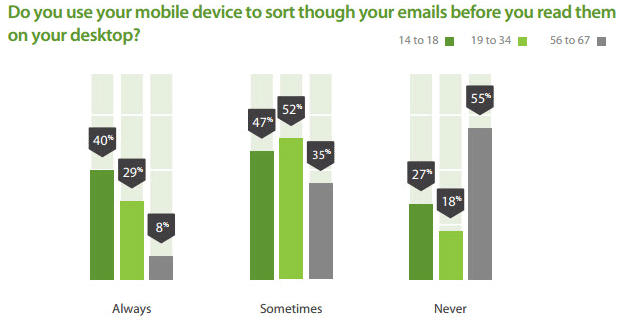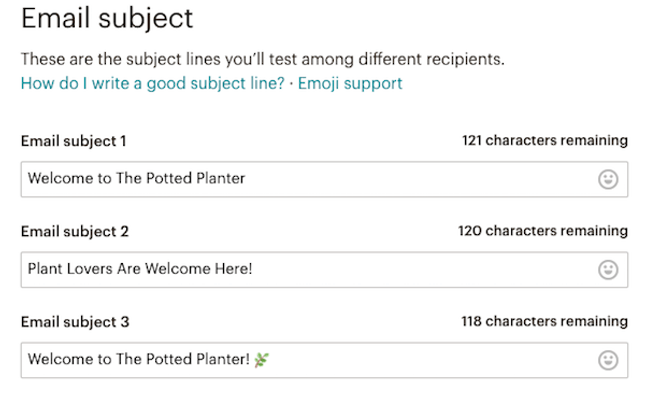How to Write an Email Subject Line | 10 Easy Tips
If you click to purchase a product or service based on our independent recommendations and impartial reviews, we may receive a commission. Learn more
Regardless of how the saying goes, the truth is that people do judge a book by its cover, and an email by its subject line.
People are busier than ever. They get dozens of emails every day, and they don’t have the time to read and respond to all of them. The subject line is the first thing people see, before deciding whether they’ll open your email. In fact, 69% of recipients report emails as spam based on the subject line alone.
For these reasons, it’s crucial to ensure that your subject line is engaging enough to trigger curiosity and boost your email campaign’s open rate.
If you want your emails to stand out from the crowd and get opened by more recipients, here are 10 proven tactics to help.
1. Keep Subject Lines Short
More and more people are checking emails on their mobile devices. If your subject lines are too long, they’ll get cut off after a few words.

Image Source: Email Monday
Consequently, we recommend that you keep subject lines to less than 50 characters. This will give people a chance to read your whole subject line.
When creating a subject line for an email, leave out any unnecessary or unimportant words – as long as it doesn’t impact the meaning. For example, let’s say you’re sending a ticket confirmation email. So instead of using a subject line such as this:
“Your ticket #8475399202 has been received”
… consider using this:
“Your ticket is confirmed”
Similarly, avoid using the words “update,” “newsletter,” and so on when writing subject lines for your regular emails.
Find Out More
- Discover our 11 Tips for Email Marketing Best Practices for more useful tips
2. Personalize Your Subject Lines
Personalizing your subject lines can go a long way in building rapport. The personal details you can use in the subject line include name, location, company name, interests, and so on.
People love getting emails that make them feel like the message is just for them, instead of a bulk broadcast to an arbitrary group. For example:
- Hey Ryan, we picked this for you!
- Ryan, this is so you and it’s 50% off!
- Ryan, here’s something you don’t want to miss
- We’d love your feedback, Ryan!
In fact, including a recipient’s name in your subject line can increase open rate by up to 18.30%.

Image Source: SuperOffice
You can personalize based on many different types of details, but just remember not to go overboard. There is a line between personalized and creepy. Nonetheless, small touches of personalization show your recipients that you value them beyond just their email address.
3. Use Action-Oriented Verbs
Great subject lines use language that inspires people to take action. By using action verbs in your subject lines, you can make them more enticing and clickable. For example, let’s consider an email inviting people to attend a dinner with Elon Musk. You can go with a subject line such as:
“Local San Francisco Business Legend Meal”
But this would be too generic, and it doesn’t start with an action verb. Now consider the alternative:
“Dine with business legend Elon Musk”
Much better, isn’t it? The word “dine” is more active and helps the reader imagine themselves sitting and having a meal with the guest of honor.
Find Out More
- Check out our full guide on Writing For the Web for a crash course in engaging your audience with your copy!
4. Ask A Question
Asking a question is one of the best ways to hook the readers with your subject line. It triggers their curiosity and makes them more likely to open the email.
For example, the real estate brand Zillow once ran an email campaign with the subject line, “What Can You Afford?” The email contained a link that directed people to a list of apartments available for rent.
This is a brilliant question because it achieves two goals: it invokes curiosity and also posts a little challenge. Most readers can’t help but click to see what’s inside an email with this kind of subject line!
5. Avoid All Caps or Too Many Exclamation Points
Have you seen these before?
- Open Now!!! and Get a Free Trial!!!
- 50% OFF SALE 24 HOURS ONLY
- !!!You have won a million dollars!!!!!
Sure, you have. Did you open these emails? Not likely.
Using subject lines with all capital letters or a lot of exclamation points is the best way to get your subject lines ignored, and to dramatically reduce your open rate. In fact, a study has shown that 85% of people prefer subject lines with lowercase letters.
When you employ such gimmicks in your subject lines, you make your readers feel like you’re yelling at them, or being aggressive. It rubs people the wrong way and conveys that they can’t trust your claims.
This is especially true with the recent rise in phishing emails, which have forced people to be more suspicious of the emails they get.
Find Out More
You should avoid all caps, but does that mean you should use all lower case? Or title case? We dig deeper into the ins and outs of Email Subject Line Capitalization in our full guide to help you find the best solution.
6. Promise a Specific Benefit
An effective email subject line is relevant to your recipients. And it conveys that relevance by being descriptive and specific. For example:
- Good: 5 proven tips to increase traffic by 20%
- Bad: Guaranteed increase in traffic today!
As you can see, the bad subject line is not descriptive enough. Plus, it has a big claim with no supporting details. In contrast, the good subject line shows the reader exactly what they’ll get from the email.
7. Use Numbers
As we discussed above, the more specific you are, the better your email subject lines. And one of the best ways to be specific is to use numbers. Take a look at the same email subject line example once again:
- Good: 5 proven tips to increase traffic by 20%
- Bad: Guaranteed increase in traffic today!
The first one uses numbers to set up clear expectations, while the second one does not. People love subject lines with concrete lists and numbers, as it makes the subject lines easier for their brains to process.
8. Invoke a Sense of Urgency
One of the most powerful motivational factors is the fear of missing out. So use the principle of scarcity. By applying some type of restriction or limitation to the benefit offered by your email, you can make your subject lines even more enticing. For example:
- Without scarcity principle: New widgets now on sale
- With scarcity principle: Only 10 widgets left on 50% discount
The first subject line makes an announcement but doesn’t make the offer scarce. The second one does, and therefore makes people afraid of losing out on such a great deal.
9. Experiment with Emojis
Subject lines with an emoji increase open rates by 56%. The web is getting more and more visual by the day, leading to an increase in the use of emojis in email subject lines. For example:
- Content Audit for Your Website
- Grow Your Startup with Content Marketing
- Your recent talk at Dreamforce
But you have to be careful when using emojis. A lot rides on your brand personality and target audience.
For example, if your recipients belong to a younger demographic, emojis can help increase email open rates. In other cases, however, it can have the opposite effect. So it’s wise to proceed with caution, which brings us to the next point.
10. Remember to Test
The best practices we’ve discussed above are great to begin with. But the success of your subject lines also depends on your unique business, target audience, and the type of email campaign. So you need a way to experiment with different subject lines and learn what works best.
That’s where A/B testing can help. To put it simply, let’s say you want to decide from three potential subject lines. Before sending an email to all of your email contacts, you can pick a small sample and divide the sample into three groups.

The first group will get emails with your first subject line, the second group will get emails with the second subject line, and so on. Once the emails have been sent, you can analyze the results to see which performed better.
Most of the modern email marketing tools provide you with built-in A/B testing features.
Why Is My Open Rate So Bad?
Apart from a subject line, there are additional factors that impact your email’s open rate. So if you’ve been following the best practices outlined above but are still seeing low open rates, then it’s time to consider the following aspects:
Are you sending too many emails?
The more emails you send, the less likely it is that people will open all your emails. So make sure you are setting the right expectations about email frequency when someone joins your email list.
Are your emails going to the spam folder?
If your emails are going straight to spam, the recipient won’t even know that you emailed them, let alone get a chance to open the email. You can use a spam checker tool, such as Mail Tester, to determine how likely your emails are to end up in spam and what you can do about it.
Are you sending emails at the wrong time?
The time of delivery matters too. For example, if you send emails on a weekend, after business hours, or Monday morning, they are less likely to be opened. Here’s our detailed guide to deciding the best time to send emails.
Email Subject Line Best Practices: Summary
Although we often treat the subject line as an afterthought, it’s actually even more important than the body of your email. At the end of the day, the best email content has no value if the email doesn’t get opened. So if you want to improve your subject lines, here’s a recap for quick reference.
Writing a killer subject line
- Keep Subject Lines Short
- Personalize Your Subject Lines
- Use Action-Oriented Verbs
- Ask A Question
- Avoid All Caps or Too Many Exclamations
- Promise a Specific Benefit
- Use Numbers
- Invoke a Sense of Urgency
- Experiment with Emojis
- Remember to Test
Remember, don’t leave your subject lines to chance. Follow the best practices above to write subject lines that give recipients a solid reason to read your emails and stay engaged with your brand!
Leave a comment